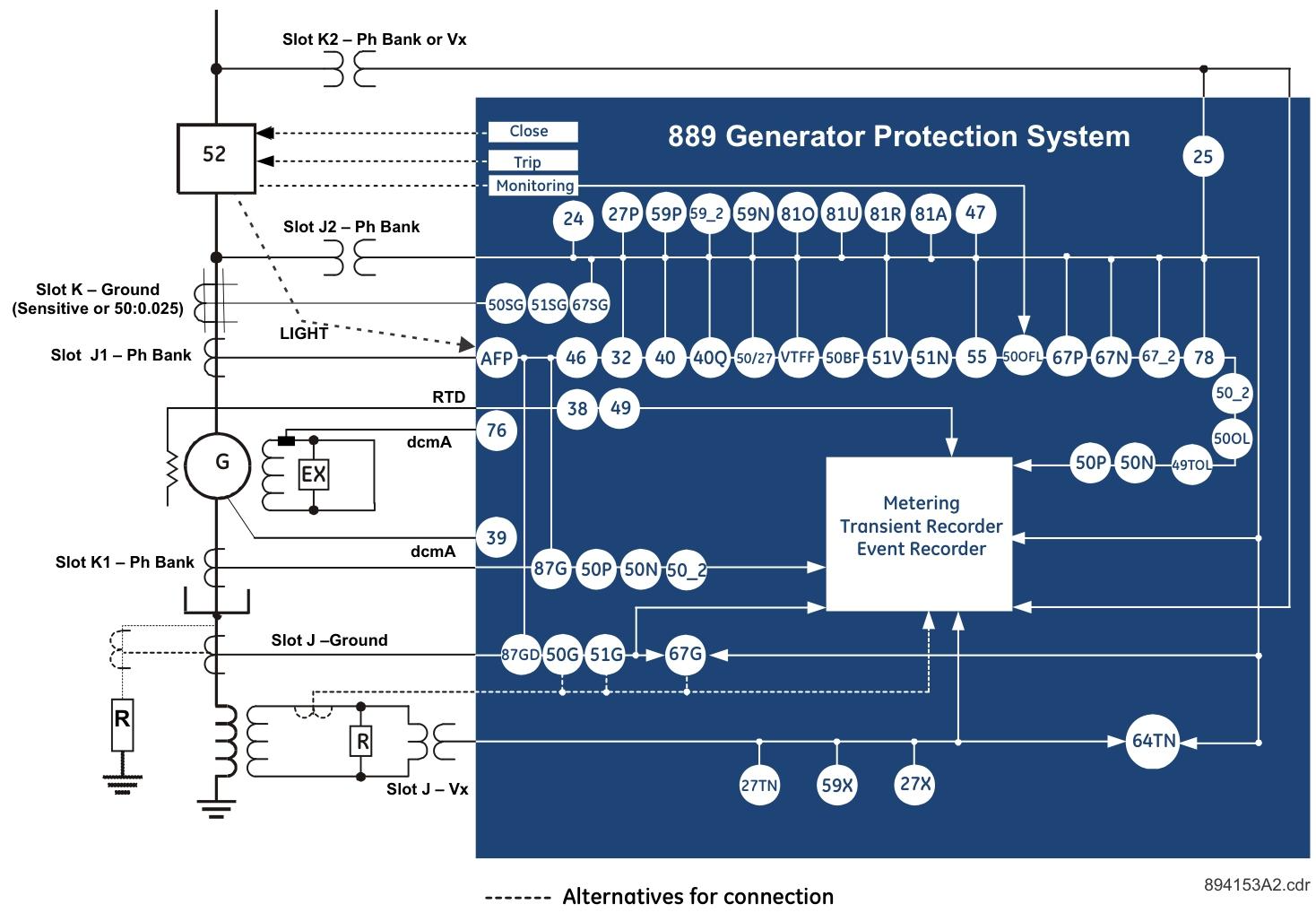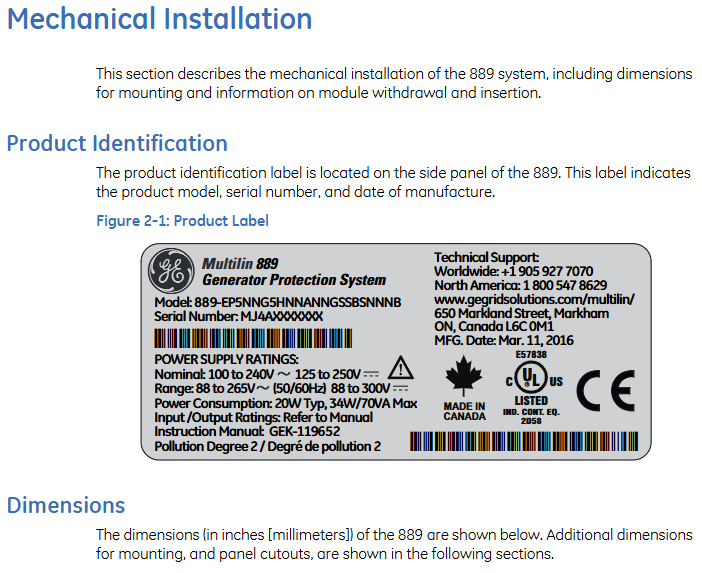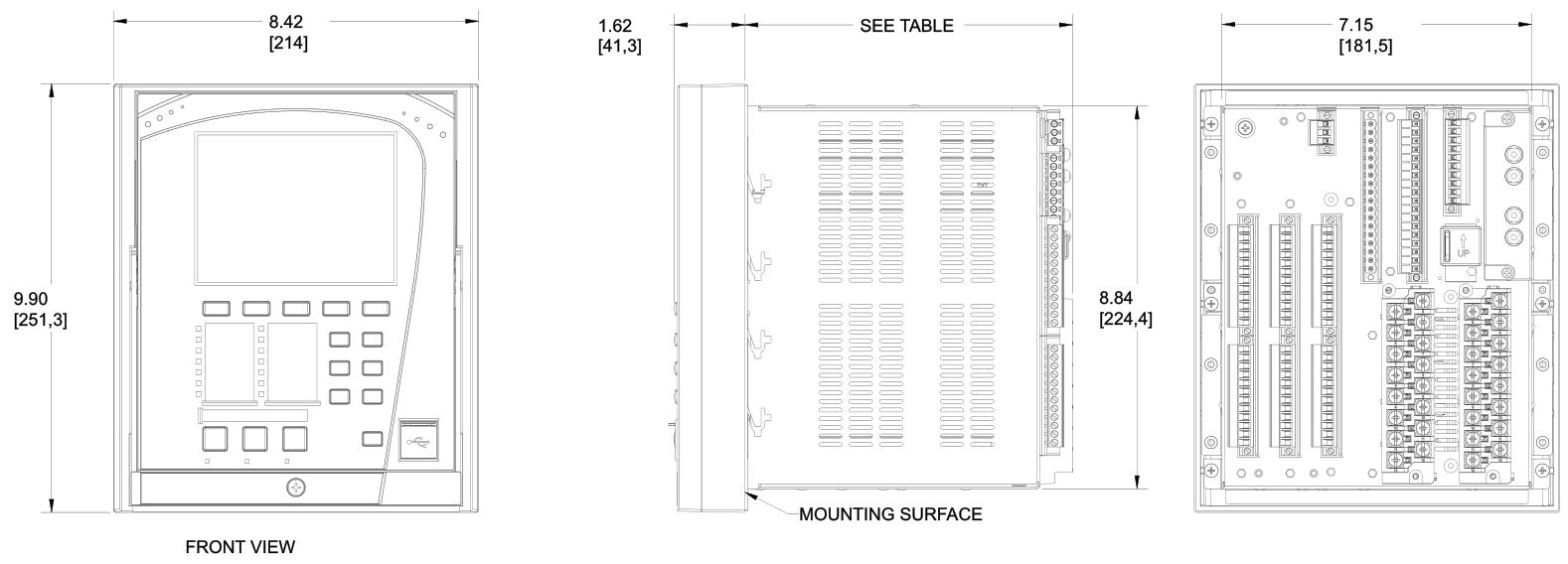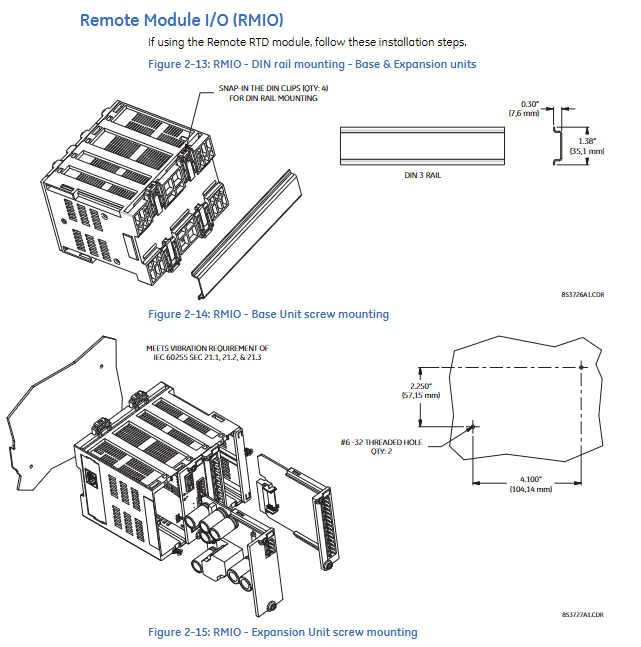

K-WANG


GE Multilin 889 Generator Protection System
GE Multilin 889 Generator Protection System
Product Overview
Core functions
The 889 generator protection system is a microprocessor based device used for primary and backup protection of small and large generators, with protection, control, and asset monitoring functions. It can monitor the imbalance, differential, overexcitation, demagnetization and other states of the generator, and meet different industry standards and user needs through flexible configuration.
main features
Protection function: covering various protection elements such as percentage differential protection, overcurrent, overvoltage/undervoltage, frequency abnormality, demagnetization, reverse power, etc. (see ANSI equipment numbering table for details).
Flexibility: Supports custom logic (FlexLogic), programmable curves (FlexCurve), multiple sets of setpoints, and default settings simplify initial configuration.
Monitoring and recording: Real time monitoring of parameters such as current, voltage, and power, with functions such as event recorder (1024 events), transient recorder (waveform capture), and fault report (15 events).
Communication capability: Supports multiple protocols such as Modbus, DNP3.0, IEC 60870-5-103/104, IEC 61850, etc., with optional interfaces such as Ethernet, RS485, Wi Fi, etc.

Installation instructions
1. Mechanical installation
Size and installation method: Supports standard panel installation, drawer installation, and can be matched with a depth reducing ring to adapt to narrow spaces; The full-size weight is about 9kg, and ventilation gaps need to be reserved at the top and bottom.
Key component installation: The power module and magnetic module (CT/VT) need to be plugged and unplugged according to the steps. Before removing the magnetic module, the system power must be disconnected and the CT secondary side short circuited to prevent high voltage hazards.
Installation of arc light sensor: The optical fiber should avoid bending with a radius less than 25mm, and the installation position should be unobstructed. It supports 4 point sensors and has a standard fiber length of 18 feet (maximum 32 feet).
2. Electrical installation
CT/VT connection: CT supports 1A/5A secondary, VT supports star/triangle connection, pay attention to phase sequence and polarity to ensure correct protection function.
Grounding requirements: The system rack, EMI shielding, and cables must be reliably grounded, and the grounding resistance of the intrinsic safety system must be<1 Ω.
Wiring specifications: The control power supply should match the rated range (such as 110-250V AC/DC), and the communication line should use shielded twisted pair. The maximum distance of RS485 is 1200 meters.

Interface Description
1. Front panel interface
Display screen and buttons: graphic LCD display, supports menu navigation (Targets, Status, Metering, etc.), 5 navigation keys+3 programmable function keys, 17 LEDs (including programmable status indication).
Operation function: It can view real-time data, set parameters, reset alarms, support single line diagram (SLD) display, and can configure default screens and color schemes.
2. Software interface (EnerVista 8 Series Setup)
Function: Used for configuring parameters, upgrading firmware, viewing records, drawing custom SLDs, etc., supporting online/offline operations.
Connection method: Connect via USB, Ethernet, Wi Fi, and configure communication parameters such as IP address and port.
Advanced features: SLD configurator (custom single circuit diagram), FlexCurve editor (custom protection curve), transient recorder (waveform analysis), etc.

Detailed explanation of core functions
1. Protection function
Differential protection: including generator stator differential (87G), overall differential (87O), supporting dual slope characteristics, 2nd/5th harmonic braking.
Overcurrent protection: including phase/neutral/ground overcurrent (50/51 series), supporting multiple inverse time curves (IEEE, IEC, etc.).
Voltage protection: Over/Under voltage (59/27 series), Negative sequence overvoltage (59_2), Voltage Hertz protection (24), etc.
Other protections: demagnetization (40), reverse power (32), abnormal frequency (81U/O/R), arc protection (AFP), etc.
2. Monitoring function
Real time monitoring: current, voltage, power, frequency, harmonics, temperature (RTD), etc., with an accuracy of ± 0.25% (current) and ± 0.5% (voltage).
Recording function: Event recording (timestamp accurate to microseconds), transient recording (waveform before and after fault), data log (configurable with 16 analog quantities).
3. Control function
Circuit breaker control: supports opening/closing, locking, and bypass, adopts the "select first, operate later" mechanism, and is compatible with local/remote control.
Synchronization check (25): Monitor voltage, frequency, and phase difference to ensure that the grid connection conditions are met.
Arc protection: Detecting arc light through fiber optic sensors, quickly triggering tripping, and reducing equipment damage.

Set point configuration
Device settings: including clock synchronization (IRIG-B, PTP, SNTP), security (user roles, password policies), and communication protocol parameters.
System settings: CT/VT parameters, generator rating, grounding method, etc.
Input/output settings: Configure analog input (such as 4-20mA), digital input (wet/dry contacts), and output relay (trip/alarm).
Protection settings: Threshold, delay, action mode (trip/alarm), etc. of each protection element, supporting multiple sets of setting point switching.
Specifications and Safety
Environmental parameters: Operating temperature -40 ° C to 60 ° C, humidity 0-95%, no condensation, seismic rating IEC 60255-21-3 Class 2.
Safety certification: CE, UL508, ISO 9001, etc., in compliance with EMC standards (EN 61000 series).
Warning: Before operation, the dangerous voltage must be disconnected, and the CT secondary side must not be open circuited. Suitable personal protective equipment must be used.

- YOKOGAWA
- Energy Access
- Renewable Integration
- Energy Subsidies
- Energy and Water
- Net zero emission
- Energy Security
- Critical Minerals
- A-B
- petroleum
- Mine scale
- Energy and Gender
- Covid-19
- man-machine
- Reliance
- ADVANCED
- SEW
- ProSoft
- WATLOW
- Kongsberg
- FANUC
- VSD
- DCS
- PLC
- Sewage treatment
- cement
- Yaskawa
- Woodward
- BOSCH Rexroth
- MOOG
- General Electric
- American NI
- Rolls-Royce
- CTI
- Honeywell
- EMERSON
- Automobile market
- xYCOM
- Motorola
- architecture
- Industrial information
- New energy
- electricity
- Construction site
- HIMA
- ABB
- Rockwell
- Schneider Modicon
- Siemens
- MAN
- GE
- TRICONEX
- Control Wave
- ALSTOM
- AMAT
- STUDER
- KONGSBERG
- MOTOROLA
- DANAHER MOTION
- Bentley
- Galil
- EATON
- MOLEX
- Triconex
- DEIF
- B&W
- ZYGO
- Aerotech
- DANFOSS
- KOLLMORGEN
- Beijer
- Endress+Hauser
- schneider
- Foxboro
- KB
- REXROTH
- YAMAHA
- Johnson
- Westinghouse
- WAGO
- TOSHIBA
- TEKTRONIX
- BENDER
- BMCM
- SMC
-
GE Hydran M2-X Enhanced Monitoring
-
ABB REG316 1mrk000809-GA Numerical Generator Protection
-
ABB RED670 1MRK004810 Line differential protection
-
GE SR750-P5-G5-S5-HI-A20-R-E Feeder protection system
-
ABB PFTL301E-1.0KN 3BSE019050R1000 PillowBlock Load cells
-
Kollmorgen S33GNNA-RNNM-00 - Brushless Servo Motor
-
Kollmorgen 6sm56-s3000-g-s3-1325 - Servo Motor
-
Kollmorgen AKM52K-CCCN2-00 - Servo Motor
-
Kollmorgen PSR3-230/75-21-202 - Power Supply
-
Kollmorgen akm24d-anc2r-00 - Servo Motor
-
Kollmorgen AKM22E-ANCNR-00 - Servo Motor
-
Kollmorgen S60300-550 - Servo Drive
-
Kollmorgen B-204-B-21 - Servomotor
-
Kollmorgen AKM21E-BNBN1-00 - Servo Motor
-
Kollmorgen TT2953-1010-B - DC Servo Motor
-
Kollmorgen pa8500 - Servo Power Supply
-
Kollmorgen BDS4A-210J-0001-207C2 - Servo Drive
-
Kollmorgen TTRB1-4234-3064-AA - DC Servo Motor
-
Kollmorgen MH-827-A-43 - Servo Motor
-
Kollmorgen AKM24D-ACBNR-OO - Servo Motor
-
Kollmorgen 00-01207-002 - Servo Disk DC Motor
-
Kollmorgen AKM21C-ANBNAB-00 - Servo Motor
-
Kollmorgen PSR3-208/50-01-003 - Power Supply
-
Kollmorgen 6SM56-S3000 - Servo Motor
-
Kollmorgen DBL3H00130-B3M-000-S40 - Servo Motor
-
Kollmorgen 6SN37L-4000 - Servo Motor
-
Kollmorgen AKM65K-ACCNR-00 - Servo motor
-
Kollmorgen 6SM56-L3000-G - Servo Motor
-
Kollmorgen AKMH43H-CCCNRE5K - Servo Motor
-
Kollmorgen PSR4/52858300 - Power Supply
-
Kollmorgen KBM-79H03-E03 - Direct Drive Rotary Motor
-
Kollmorgen AKM33E-ANCNDA00 - Servo Motor
-
Kollmorgen U9M4/9FA4T/M23 - ServoDisc DC Motor
-
Kollmorgen AKM13C-ANCNR-00 - Servo Motor
-
Kollmorgen AKM43L-ACD2CA00 - Servo Motor
-
Kollmorgen AKM54K-CCCN2-00 - Servo Motor
-
Kollmorgen M-605-B-B1-B3 - Servo Motor
-
Kollmorgen AKD-P00606-NBAN-0000 - Rotary Drive
-
Kollmorgen 6SM-37M-6.000 - Servo Motor
-
Kollmorgen A.F.031.5 - Sercos Interface Board
-
Kollmorgen 918974 5054 - Servo PWM
-
Kollmorgen U12M4 - ServoDisc DC Motor
-
Kollmorgen AKD-B00606-NBAN-0000 - Servo Drive
-
Kollmorgen MV65WKS-CE310/22PB - Servo Drive
-
Kollmorgen 65WKS-CE310/22PB - Servo Drive
-
Kollmorgen EM10-27 - Module
-
Kollmorgen S64001 - Servo Drive
-
Kollmorgen CR03200-000000 - Servo Drive
-
Kollmorgen 6SM57M-3000+G - Servo Motor
-
Kollmorgen BDS4 - Servo Drive
-
Kollmorgen AKD-P00306-NBEC-000 - Servo Drive
-
Kollmorgen AKD-B01206-NBAN-0000 - Servo Drive
-
Kollmorgen STP-57D301 - Stepper Motor
-
Kollmorgen 6SM37L-4.000 - Servo Motor
-
Kollmorgen 44-10193-001 - Circuit Board
-
Kollmorgen PRDR9SP24SHA-12 - Board
-
Kollmorgen PRD-AMPE25EA-00 - Servo Drive
-
Kollmorgen DBL3N00130-0R2-000-S40 - Servo Motor
-
Kollmorgen S406BA-SE - Servo Drive
-
Kollmorgen AKD-P00607-NBEI-0000 - Servo Drive
-
Kollmorgen AKD-P01207-NBEC-0000 - Servo Drive
-
Kollmorgen CR03550 - Servo Drive
-
Kollmorgen VSA24-0012/1804J-20-042E - Servo Drive
-
Kollmorgen N2-AKM23D-B2C-10L-5B-4-MF1-FT1E-C0 - Actuator
-
Kollmorgen 04S-M60/12-PB - Servo Drive
-
Kollmorgen H33NLHP-LNW-NS50 - Stepper Motor
-
Kollmorgen A-78771 - Interlock Board
-
Kollmorgen AKM43E-SSSSS-06 - Servo Motor
-
Kollmorgen AKD-P00607-NBEC-0000 - Servo Drive
-
Kollmorgen E21NCHT-LNN-NS-00 - Stepper Motor
-
Kollmorgen cr10704 - Servo Drive
-
Kollmorgen d101a-93-1215-001 - Motor
-
Kollmorgen BDS4A-203J-0001-EB202B21P - Servo Drive
-
Kollmorgen MCSS23-6432-002 - Connector
-
Kollmorgen AKD-P01207-NACC-D065 - Servo Drive
-
Kollmorgen CK-S200-IP-AC-TB - I/O Adapter and Connector
-
Kollmorgen CR10260 - Servo Drive
-
Kollmorgen EC3-AKM42G-C2R-70-04A-200-MP2-FC2-C0 - Actuator
-
Kollmorgen BDS5A-206-01010-205B2-030 - Servo Drive
-
Kollmorgen s2350-vts - Servo Drive
-
Kollmorgen AKM24D-ANC2DB-00 - Servo Motor
-
Kollmorgen E31NCHT-LNN-NS-01 - Stepper Motor
-
Kollmorgen PRD-0051AMPF-Y0 - Servo Board
-
Kollmorgen TB03500 - Module
-
Kollmorgen 60WKS-M240/06-PB - Servo Drive
-
Kollmorgen M21NRXC-LNN-NS-00 - Stepper Motor
-
Kollmorgen H-344H-0212 - Servo Motor
-
Kollmorgen MCSS08-3232-001 - Connector
-
Kollmorgen AKM33H-ANCNC-00 - Servo Motor
-
Kollmorgen PA-2800 - Power Supply
-
Kollmorgen MTC308C1-R1C1 - Servo Motor
-
Kollmorgen PRDR0091300Z-00 - Capacitor Board
-
Kollmorgen BDS4A-206J-0024/01502D79 - Servo Drive
-
Kollmorgen S20330-VTS - Servo Drive
-
Kollmorgen S20250-CNS - Servo Drive
-
Kollmorgen SBD2-20-1105-WO - Servo Drive Board
-
Kollmorgen M405-C-A1--E1 - Servo Motor
-
Kollmorgen PRD-PB805EDD-00 - Servo Drive
-
Kollmorgen 6SM57S-3.000-J-09-HA-IN - Servo Motor
-
Kollmorgen AKM33H-ANCNDA-00 - Servo Motor
-
Kollmorgen PCB-00030200-04 - PCB
-
Kollmorgen H22SSLB-LNN-NS-02 - Stepper Motor
-
Kollmorgen BJRL-20012-110001 - Module
-
Kollmorgen BDS4A-206J-0001404A - Servo Drive
-
Kollmorgen H-342-H-0802 - Servo Motor
-
Kollmorgen CR10561 - Servo Drive
-
Kollmorgen BDS5A-206-00010-205B2-030 - Servo Drive
-
Kollmorgen BDS5A-206-00010-207B-2-030 - Servo Drive
-
Kollmorgen mcss08-3224-001 - Connector
-
Kollmorgen M-207-B-23-B3 - Servo Motor
-
Kollmorgen PRD-0041200Z-S0 - Encoder/Resolver Card
-
Kollmorgen MH-225-G-61 - Motor
-
Kollmorgen MT308B1-T1C1 - Servo Motor
-
Kollmorgen BDS4A-240J-0001604C83 - Servo Drive
-
Kollmorgen 6SM57-S-3000 - Servo Motor
-
Kollmorgen N-T31V-15-5B-6-MF3-FT1E-C251 - Actuator
-
Kollmorgen PRD-0051AMPA-X0 - Servo Board
-
Kollmorgen CF-SS-RHGE-09 - Cable
-
Kollmorgen DIGIFAS7204 - Servo Drive
-
Kollmorgen S30101-NA - Servo Drive
-
Kollmorgen DIGIFAS7201 - Servo Drive
-
Kollmorgen PRD-0051AMPA-Y0 - Servo Board
-
Kollmorgen AKM23D-EFCNC-00 - Servo Motor
-
Kollmorgen SE10000 - Servo Drive
-
Kollmorgen PSR4/5A-112-0400 - Power Supply
-
Kollmorgen AKM31H-ANCNC-01 - Servo Motor
-
Kollmorgen M-203-B-93-027 - Servo Motor
-
Kollmorgen CP-SS-G1HE-05 - Connector




